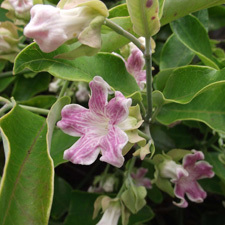 Moth plant
Moth plant
Common name: Moth plant; kapok plant
Botanical name: Araujia hortorum
Management programme: Sustained control - Rule 5a applies
Originally from South America. It was introduced to New Zealand as an ornamental species and recorded as naturalised in 1888.
Why is it a pest?
- Grows rapidly forming large, heavy, long-lived masses in the canopy.
- Produces masses of viable seed that travel long distances via wind.
- Smothers plants and prevents the establishment of native plants.
- Butterflies feeding on moth plant can die from starvation due to feeding parts becoming gummed up.
- Sap is poisonous and can be a skin irritant.
Where is it found?
Almost any frost free habitat including intact and disturbed forests and margins, tracks, cliffs, coastline, shrublands, mangroves and inshore and offshore islands.
What does it look like?
- Rampant, evergreen vine with a smelly, milky sap and twining flexible stems that are covered in down and woody near the base.
- Dark green leaves are hairless and dull on top and greyish-downy underneath and opposite on the stems.
- Clusters of 2-3 bell shaped white flowers (December to May), occasionally with pink streaks, are followed by distinctive thick, leathery, pear shaped choko-like pods (autumn - winter).
- Pods contain kapok-like pulp which splits open to disperse many black, thistle-down like seeds.
How can you help?
If you’re interested in getting involved and getting rid of moth plant, you’re in luck! There are two initiatives running until the end of May. In the East of the region, Halo Whakatāne are running their 2nd Annual D.O.M.P Comp, and in the West, Envirohub have organised a seed challenge to rid the region of this pest.
What are the rules?
Sustained control
Sustained Control pests are well established in the region and preventing the spread is no longer a realistic objective. Management focuses on reducing general impacts of the pest. Landowners/occupiers are responsible for the control of these pest species on their land. Council may enforce control.
Under rule 5a of the RPMP landowners/occupiers must destroy this pest if required by a written direction from an authorised person unless a property specific pest management agreement has been agreed and signed between the occupier and the Council.
Criteria to meet Rule 5A include when the species is being actively managed by council, other agency and or community group, on an adjacent property. See the Regional Pest Management Plan 2020-2030 rules for Sustained control pests for more information.
How do you get rid of it?
Poisonous and can cause dermatitis, protect skin against contact with sap. Destroy ripe pods first to minimise seed. Pods should be incinerated, buried deeply or disposed of at refuse station.
- Hand pull (all year)
- Cut and Paste (summer to autumn)
- Spraying (summer to autumn)
CAUTION: When using any herbicide or pesticide, PLEASE READ THE LABEL THOROUGHLY to ensure that all instructions and directions for the purchase, use and storage of the product, are followed and adhered to.
Read more on pest control advice, information and regulations.
Images






